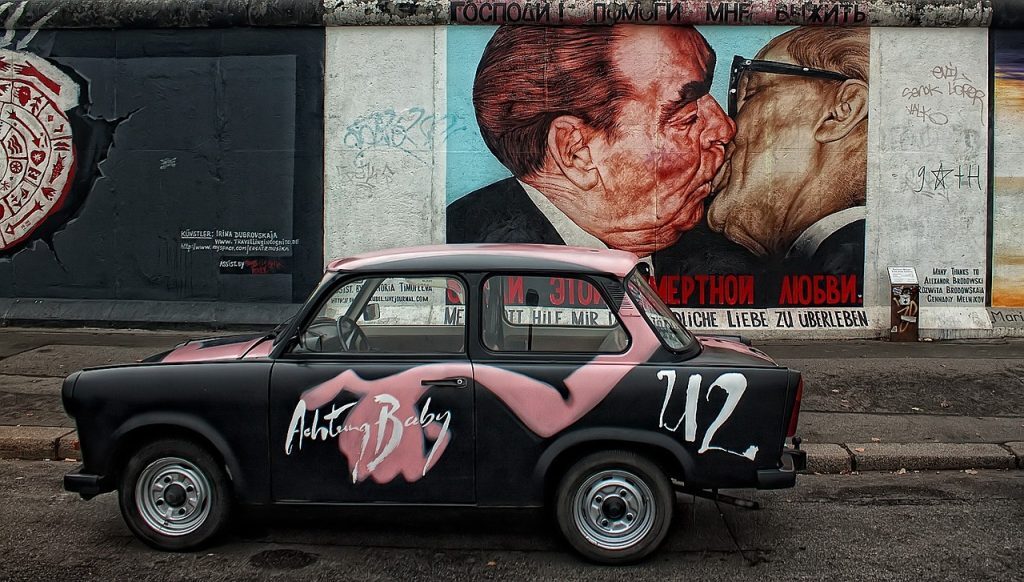In the end, it was a silly mistake that saw the Berlin Wall ripped down. Under pressure, the East German government planned to ease travel restrictions to and from east and west Berlin, but the apparatchik announcing it at a press conference mistakenly said: “with immediate effect”.
By that night, people were tearing down the wall, the greatest symbol of the oppression of the failed Soviet empire. The fall of the Berlin Wall was as capricious as it was swift. The irony is too delightful.
Last week, I stood where the Berlin Wall was. My hotel was built in mine-infested no-man’s land. Call me sentimental, but I was blown away by that.
More than anything else the Berlin Wall stood for that strange Cold War conflict, that lasted for nearly half of the last century. It was the ultimate symbolism of Communism. Its demise was the more powerful signifier of the death of that once-mighty ideology. I grew up in the 1980s not only through apartheid’s worst years but the global nuclear standoff’s most tense time, with the threat of that phrase only political strategists could come up with: “mutually-assured destruction”.
I stood on the spot — so meaningfully represented by cobbles and other paving stones where the wall itself stood — and marvelled at the enormous transformation we’ve lived through. Amazingly, it’s nearly 20 years [now 27] since the Wall came down on 9 November 1989.
I went to Checkpoint Charlie, the legendary crossing point between the two countries. Now it’s a tourist trap: young Berliners pose as American and Russian border guards for you to take your picture with, or stamp faux passports with recreations of the multiple visas you needed to cross from East to West.
Right next door, on the eastern side, there’s a bunch of takeaway joints (pizza, Chinese and that subtle branch of American imperialism, Subway) called Snack Point Charlie.
And yet, every day, I walked to where the wall was and I stood in awe. Growing up, the Berlin Wall was immutable, the very face of Communism. It seemed set in stone, it was utterly improbable that it would fall — no matter how many American presidents declared: “Ich bin ein Berliner” (Kennedy in 1963) or “Mr Gorbachev, tear down this wall” (Reagan in 1987).
Reminders of Berlin’s past are everywhere, perhaps more for the tourists than a reminder of the evil that lurks in humanity’s soul. I frequently spotted that famous picture of the East German border guard leaping the barbed wire to escape to the West.
As touched as I was by the history of Berlin, I was amazed at the radical newness of it. Readers of this column may know I’m an architecture geek. Berlin is a treat for the eyes and any architectural sensibility, even if you don’t know that back in 1929 German architect Ludwig Mies van der Rohe, one of my personal heroes, created the floor-to-ceiling glass walls that now predominate modern architecture.
It’s fitting then that Berlin is the home to the IFA trade fair, a massive consumer electronics show I was attending for the first time, and for a week the epicentre of not just technology but hope.
IFA, for Internationale Funkausstellung, is a bellwether for end-of-year tech sales and is being eagerly watched for signs of an economic upturn, especially as Germany is Europe’s largest economy.
In a city known for the thickest of walls, it was perhaps fitting that the product I was most impressed with was a Samsung TV as thin as a pencil.
There was a range of new netbooks and other compact, battery- enhanced laptops, as well as the big new trend, 3D televisions from Samsung, Sony and Panasonic.
But every day I went and stood where the wall once was and marvelled.
Call me sentimental, but we’ve lived through the fall of apartheid and the Berlin Wall. That’s pretty amazing fortitude for the human spirit.
This article originally featured in The Times
